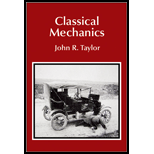
Concept explainers
(a)
To prove that
(a)
Answer to Problem 15.101P
It is proved that
Explanation of Solution
Write the expression for transformed electric field using standard boost.
Here,
Write the expression for transformed electric field using standard boost.
Here,
Write the expression for transformed electric field using standard boost.
Here,
Write the expression for transformed of magnetic field using standard boost.
Here,
Write the expression for transformed of magnetic field using standard boost.
Here,
Write the expression for transformed of magnetic field using standard boost.
Here,
Write the equation for
Use equation (I), (II), (III), (IV), (V) and (VI) in the above equation.
Rearrange the above equation.
The above equation can be written as
Write the equation for
Rearrange the above equation.
Since
Use the above condition in equation (IX).
Conclusion:
Therefore, it is proved that
(b)
To prove that if
(b)
Answer to Problem 15.101P
It is proved that if
Explanation of Solution
When electric field
Since
Conclusion:
Therefore, it is proved that if
(c)
To prove that if
(c)
Answer to Problem 15.101P
It is proved that if
Explanation of Solution
Consider that in frame
Write the relation between
Square the above equation on both the sides.
But
Use the above condition in equation (X).
Since
From the above equation it is clear that
Conclusion:
Therefore, it is proved that if
Want to see more full solutions like this?
Chapter 15 Solutions
Classical Mechanics
 College PhysicsPhysicsISBN:9781305952300Author:Raymond A. Serway, Chris VuillePublisher:Cengage Learning
College PhysicsPhysicsISBN:9781305952300Author:Raymond A. Serway, Chris VuillePublisher:Cengage Learning University Physics (14th Edition)PhysicsISBN:9780133969290Author:Hugh D. Young, Roger A. FreedmanPublisher:PEARSON
University Physics (14th Edition)PhysicsISBN:9780133969290Author:Hugh D. Young, Roger A. FreedmanPublisher:PEARSON Introduction To Quantum MechanicsPhysicsISBN:9781107189638Author:Griffiths, David J., Schroeter, Darrell F.Publisher:Cambridge University Press
Introduction To Quantum MechanicsPhysicsISBN:9781107189638Author:Griffiths, David J., Schroeter, Darrell F.Publisher:Cambridge University Press Physics for Scientists and EngineersPhysicsISBN:9781337553278Author:Raymond A. Serway, John W. JewettPublisher:Cengage Learning
Physics for Scientists and EngineersPhysicsISBN:9781337553278Author:Raymond A. Serway, John W. JewettPublisher:Cengage Learning Lecture- Tutorials for Introductory AstronomyPhysicsISBN:9780321820464Author:Edward E. Prather, Tim P. Slater, Jeff P. Adams, Gina BrissendenPublisher:Addison-Wesley
Lecture- Tutorials for Introductory AstronomyPhysicsISBN:9780321820464Author:Edward E. Prather, Tim P. Slater, Jeff P. Adams, Gina BrissendenPublisher:Addison-Wesley College Physics: A Strategic Approach (4th Editio...PhysicsISBN:9780134609034Author:Randall D. Knight (Professor Emeritus), Brian Jones, Stuart FieldPublisher:PEARSON
College Physics: A Strategic Approach (4th Editio...PhysicsISBN:9780134609034Author:Randall D. Knight (Professor Emeritus), Brian Jones, Stuart FieldPublisher:PEARSON





